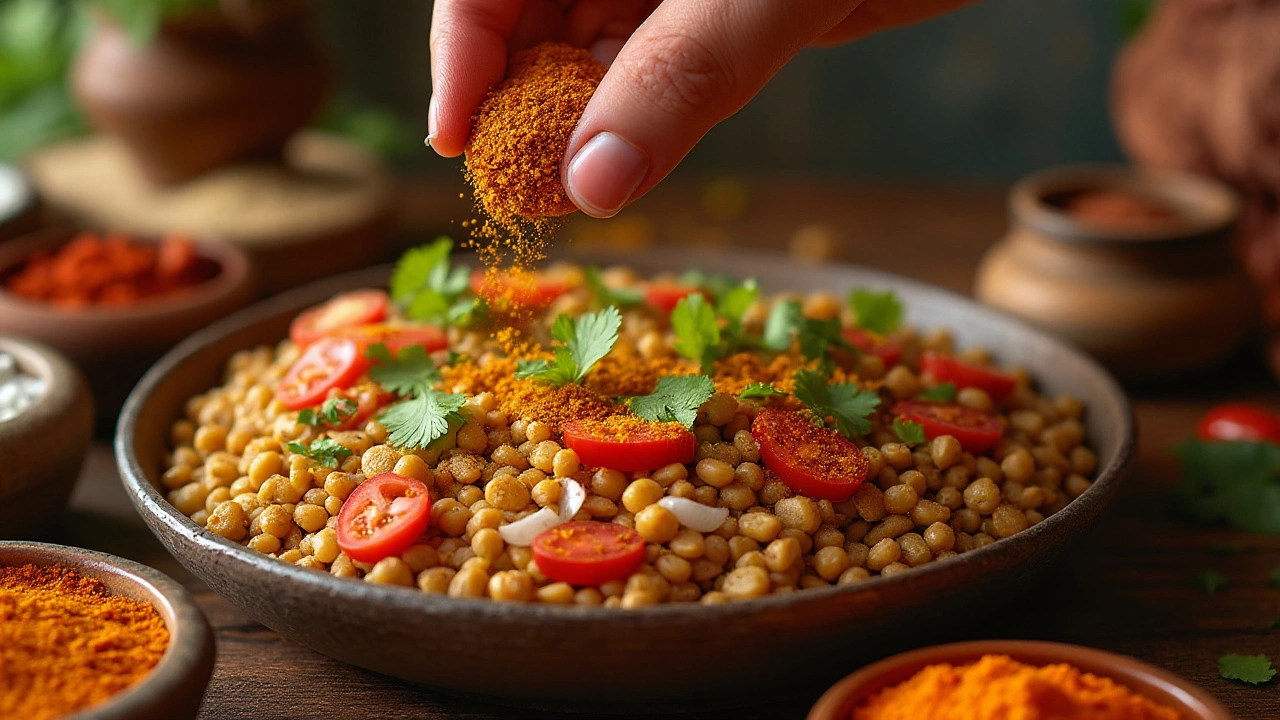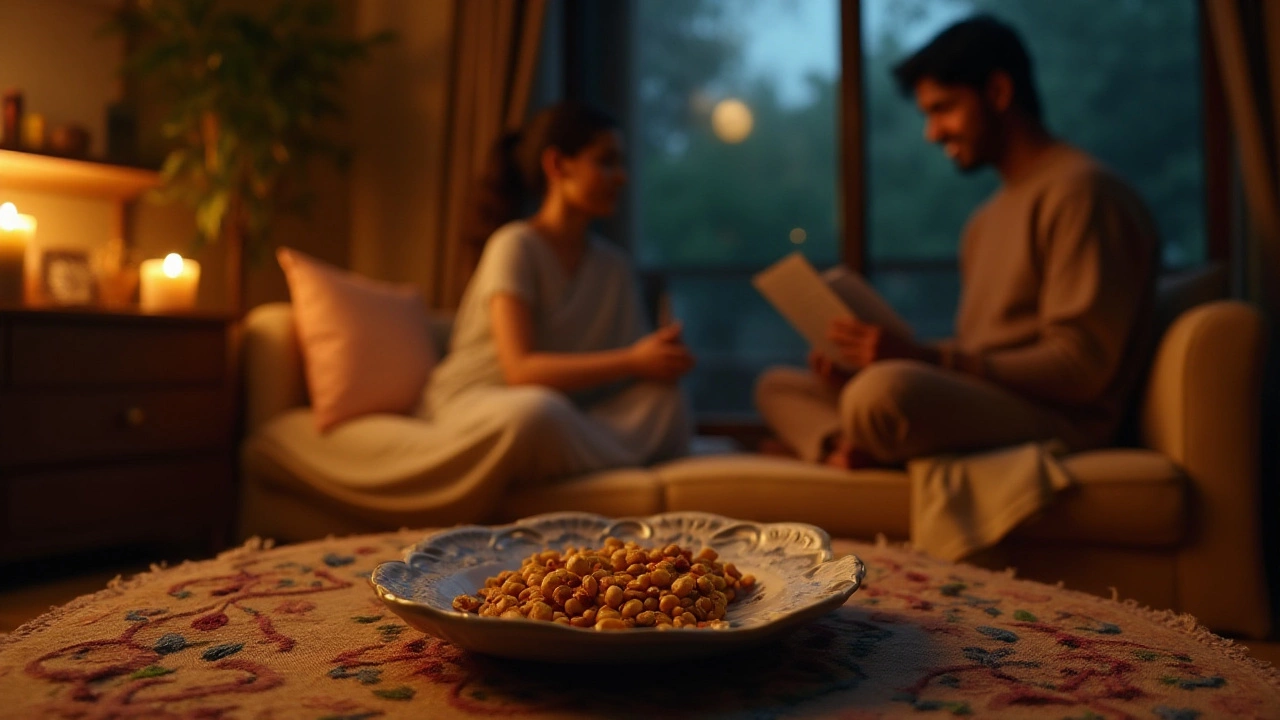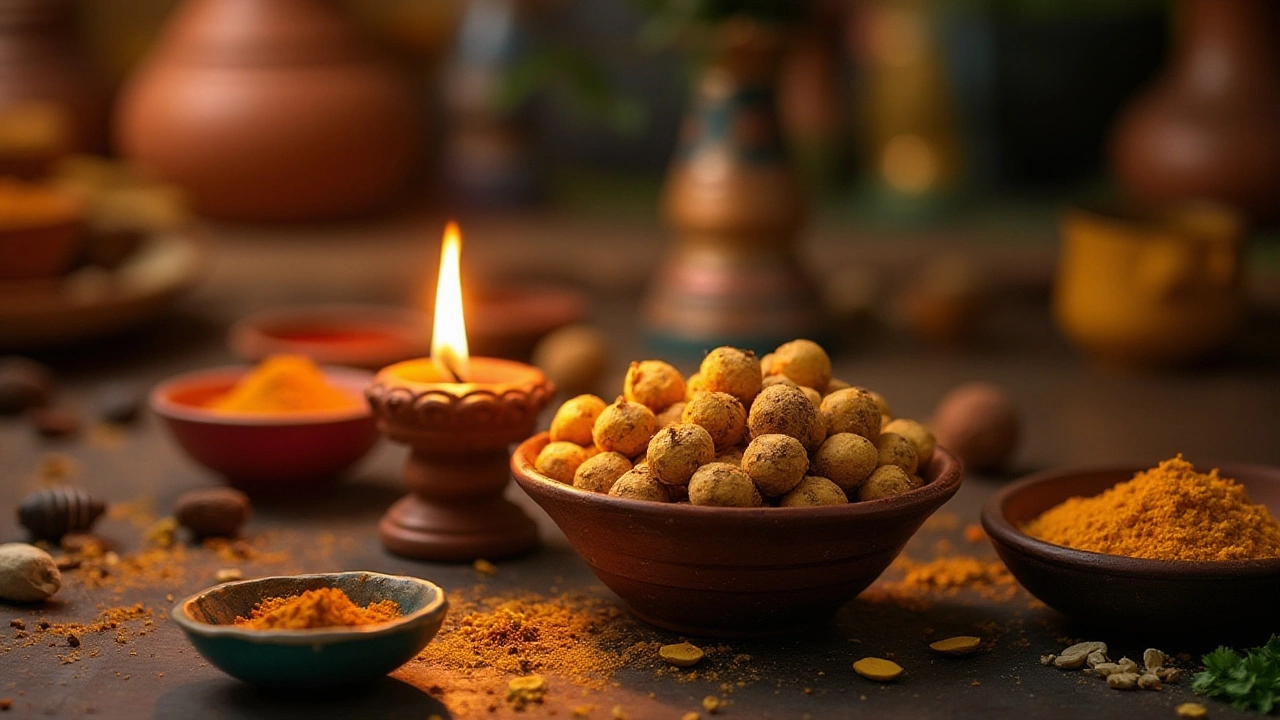16 Dec 2024
- 0 Comments
Late-night cravings are a common experience, sneaking up on most of us when least expected. As the day winds down, the urge for something delightful yet harmless to our health often arises. Luckily, Indian cuisine offers an array of snacks that cater perfectly to these needs, satisfying taste without a side of guilt.
From the ancient kitchens of India, snacks like roasted makhana—puffed lotus seeds renowned for their health benefits—and vibrant lentil chaat lend themselves as ideal nighttime treats. These options are not only delicious but also aligned with the principles of wholesome eating.
Embrace the simplicity of these traditional offerings, and discover a way to indulge your cravings with minimal impact on your health goals. Let's explore a selection of Indian snacks, delve into their nutritious qualities, and learn tips on keeping your late-night nibbling both satisfying and smart.
- Understanding night-time cravings
- Why choose traditional Indian snacks
- Makhana: The superfood you need
- Spiced lentil chaat: A zesty option
- The benefits of portion control
- Mindful late-night eating tips
Understanding Night-Time Cravings
When the sun dips below the horizon and the world around quiets down, night-time cravings begin their stealthy approach. These cravings are not merely a call from our appetites but are intertwined with the body's natural metabolic rhythms. Research indicates that our hunger hormones, particularly ghrelin, tend to increase in the evening, ramping up the sensation of hunger. This hormonal rollercoaster is further exacerbated by lifestyle factors like irregular meal timings and heightened stress levels from demanding workdays. Studies have shown that stress prompts the body to seek comfort in food, often leading to late-night binge eating. But why do we reach for snacks instead of healthier alternatives, and more importantly, why might Indian snacks be an obvious and healthier choice?
Night-time cravings are not only about hunger but also deeply psychological. Emotionally, these are the hours when we often process the day's events, leading to emotional eating as a coping mechanism. Imagine finishing a long day at work, and as you unwind, that desire for something savory or sweet starts creeping in. The idea of a little indulgence seems harmless, almost comforting. However, it's essential to understand the dynamic at play here—our brain's reward system lights up as we think about the taste and texture of those beloved snacks. It's this system that often has us reaching for something quick and gratifying, even if we're not truly hungry.
Certain essential elements can come into play during night-time munchies, including sleep habits. A credible study from the American Journal of Clinical Nutrition highlights that a lack of sleep significantly boosts caloric intake, particularly through snacks consumed after 8 PM.Understanding these aspects can help us navigate such cravings with more mindfulness.
Interestingly, the body might also be telling us it needs specific nutrients or even hydration. Dehydration often masquerades as hunger, and many of us are guilty of ignoring our body's need for water, mistaking it for a craving instead. Sipping on herbal teas or simply hydrating may help mitigate the intensity of these urges. As we explore this further, traditional Indian snacks offer a middle ground, meeting the desire for something tasty while ensuring we don't go off the nutritional rails. Such snacks can be balanced with healthy ingredients to reduce any negative impact. Opting for a roasted makhana or a lightly spiced lentil mixture can cater to these cravings without sacrificing health.
Why Choose Traditional Indian Snacks
Traditional Indian snacks are more than just flavorful bites—they're a testament to centuries of culinary wisdom and cultural heritage. These snacks embody the careful balance of taste and health, harnessing natural ingredients and time-tested methods. Many may wonder why they should turn to Indian options for their late-night cravings. Well, the answer lies in the unique combination of health benefits and taste that these snacks provide. Indian snacks like bhel puri, upma, and the iconic samosa carry not just flavors from various regions but also nutrients that modern diets often lack. Traditionally prepared using whole grains, pulses, and a variety of spices, these snacks offer a rich source of protein, fiber, and antioxidants, essential for maintaining health and satiety during late hours.
The nutritional richness of these snacks can't be overstated. Ingredients like lentils, chickpeas, and whole grains form the base for many Indian snacks, providing a slow release of energy that helps keep those pesky cravings at bay without resorting to unhealthy alternatives. Besides, spices such as turmeric, cumin, and coriander not only enhance the flavors but also offer anti-inflammatory and digestive benefits, acting as natural aids for your body. Notably, roasted makhana or puffed lotus seeds are considered a superfood, often heralded for their antioxidant properties; they serve as an excellent option for health-conscious snackers.
"Food is not just fuel, it’s information. It talks to your DNA and tells it what to do. The most powerful tool to change your health and change the world is your fork." - Dr. Mark Hyman
Choosing traditional Indian snacks is a step towards embracing a more mindful and health-centric lifestyle. These options are rooted deeply in practices that emphasize sustainability and natural preparation methods. Utilization of minimal processing and reliance on fresh produce and pulses means they inherently avoid artificial additives and preservatives found in many modern snack foods. Furthermore, the art of Indian cooking often values portion control, as small servings are filled with diverse flavors, letting your taste buds enjoy a symphony of tastes without going overboard. This is why Indian snacks are perfectly aligned with the goals of intuitive eating and portion mindfulness.
The global allure of traditional Indian snacks lies in their adaptability too. Whether it's a spicy kurkure or a sweet jaggery-coated peanut rolled into a chikki, these offerings can cater to varied taste preferences while still delivering the health benefits their core ingredients provide. Moreover, they can be customized based on dietary preferences, making them suitable for vegetarians, vegans, and those preferring gluten-free options. As we shift toward a lifestyle eager for both nourishment and indulgence, Indian snacks embody the ideal of balanced eating, packing health in every flavorful bite. Exploring these delicacies offers a delightful journey through flavors while keeping our well-being in mind.

Makhana: The Superfood You Need
When it comes to healthy late-night snacks, makhana stands tall as a superstar. Also known as fox nuts or lotus seeds, makhana has been an integral part of Indian culinary traditions for centuries. This humble seed boasts of health benefits that are difficult to overlook, especially when late-night hunger strikes. What makes makhana popular among health enthusiasts is its rich nutritional profile. Packed with protein, carbohydrates, and magnesium, these light puffs help satiate hunger without loading your body with unnecessary calories.
One advantage of makhana is its adaptability. It can be flavored and spiced in countless ways, allowing you to tweak it according to your taste. Whether you like a dash of black pepper, a hint of turmeric, or even a sprinkle of chaat masala, makhana accommodates all. It's an excellent companion for those keen on maintaining a healthy weight or looking for gluten-free options. Nutritionists often recommend makhana due to its low sodium content, which makes it heart-friendly.
Makhana is a superior snack choice, aligning with both taste preferences and health considerations in ways few other snacks can match. – Nutritionist Anjali Mukherjee
Incorporating makhana into your diet is as simple as it gets. A quick roast in a non-stick pan can transform raw seeds into crunchy bites of joy. You can even use these lotus seeds as toppings for salads or mix them into your breakfast cereals for an extra dose of nutrition. Many have turned to makhana as a popcorn replacement given its similar texture and ability to absorb flavors. It's worth noting that makhana also contains antioxidants which are crucial for combating cell damage. Antioxidants help in reducing inflammation and bolstering the immune system.
For anyone tracking their calorie intake, here’s an interesting fact: 100 grams of roasted makhana contain only around 347 calories. Here's how it compares to other snacks:
| Snack | Calories (per 100g) | Protein (per 100g) |
|---|---|---|
| Roasted Makhana | 347 | 9.7g |
| Potato Chips | 536 | 6.3g |
| Popcorn | 382 | 11.5g |
Beyond numbers, what truly underscores makhana’s appeal is its cultural significance. It's often used in religious ceremonies and is revered for its purity and sustenance properties. As you explore healthy Indian snacks for your night escapades, makhana presents itself not just as food, but as a bridge to traditions honoring both flavor and wellness. Next time your clock strikes midnight and cravings beckon, let a bowl of spiced makhana be your guide to healthy midnight munching.
Spiced Lentil Chaat: A Zesty Option
Spiced lentil chaat is a vibrant addition to the array of Indian snacks designed to make your late-night snacking both joyful and nutritious. This delightful dish combines cooked lentils, onions, tomatoes, herbs, and spices, making it a powerhouse of flavors that dance on your taste buds. Its creation is grounded in the genius of Indian street food, where the need for quick, flavorful bites has birthed numerous beloved dishes. Lentils, known as 'daal' in Hindi, serve as the primary ingredient, but it’s the spices that elevate this chaat to a culinary marvel.
The nutritional benefits of lentils cannot be overstated. They are loaded with essential nutrients such as protein, making them a reliable plant-based protein source. This makes spiced lentil chaat not only delicious but also an excellent choice for those inclined towards health and wellness. An excellent blend of chaat masala, lemon juice, and green chilies makes every mouthful a zesty explosion, full of tangy goodness. You can further enrich this snack by adding crunchy sev or chickpea flour noodles, which provide texture variability, turning each bite into an exciting endeavor.
Emphasizing the art of making spiced lentil chaat lies in mastering the balance of its ingredients. It is about knowing how much lemon brings brightness without overwhelming, and where a sprinkle of coriander offers freshness. Such elements are critical when aiming to achieve a snack that is healthy, tasty, and deeply satisfying. Many Indian chefs swear by the authenticity of traditional blending methods; one such chef, Ritu Dalmia, mentions, "Every chaat tells a story, of the streets it has traversed and the palates it has wooed across the world."
The preparation process is straightforward yet allows room for creativity. Begin with cooked lentils that are tender yet firm to maintain texture. Chop onions and tomatoes finely, providing juice and crunch. Mix them in a bowl with lentils, sprinkle in your chosen spices, and add green chilies for heat. Drizzle with lemon juice, and do not skimp on the fresh coriander. Toss them gently until everything is coated evenly. Serve the blend chilled or at room temperature, accompanied by a handful of sev for garnish. The healthy eating aspect is maintained by minimizing oil and focusing on fresh ingredients.
For those mindful of evening snacks' impact on health, spiced lentil chaat provides a solution. It satisfies hunger, provides energy without the heavy feeling, and delivers a dose of essential vitamins and minerals. Diversifying the dish by introducing elements like boiled potatoes or pomegranate seeds can enhance the nutritional profile while keeping the calorie count low. One Indian matron once quipped, "The secret to boutique-level chaat is in the love you fold into each ingredient," emphasizing that personal touch transforms food into a comfort dish.
To highlight its nutritious placement among other late-night snacks, a simple comparison can be telling about its advantages:
| Snack Item | Calories per 100g | Protein | Fat |
|---|---|---|---|
| Spiced Lentil Chaat | 120 | 9g | 1g |
| Potato Chips | 530 | 7g | 35g |
This table clearly shows how spiced lentil chaat is a lighter and protein-rich option compared to conventional munchies, making it ideal for health-conscious individuals. Integrating it into your diet can make night-time eating both indulgent and beneficial, ensuring your cravings are not just appeased but relished.

The Benefits of Portion Control
Portion control often gets overlooked in the quest for healthy living, especially when those late-night munchies hit. But it's a powerful tool that can help manage weight and improve digestion in the long run. Whether it's healthy snacks or any other meal, being mindful of how much you eat can make a significant difference. Portion control helps ensure that you're consuming the right amount of calories for your needs, which is essential for maintaining energy levels and preventing excessive weight gain. This is particularly important during the night, as the body naturally winds down and processes nutrients differently compared to daytime.
Deeper understanding of portion control can also enhance your relationship with food. Instead of restricting yourself, it encourages balance and conscious eating, promoting satiety without the discomfort of overeating. This becomes increasingly vital at night, when metabolic rates lower, and the chance of storing unused calories as fat increases. By managing portion sizes, especially with Indian snacks that are often rich and flavorful, you can enjoy the full culinary experience without compromising your health.
Moreover, controlling portions can be a great way to savor the flavors of each ingredient. With each smaller bite, you become more aware of the textures and tastes, amplifying the eating experience. This can be particularly delightful with snacks like makhana or lentil chaat, where spices and seasonings play a vital role. According to a study by the National Institutes of Health, individuals who practiced portion control reduced their caloric intake by around 300 calories per day compared to those who did not.
"Our Eating Habits Define Our Health to a Great Extent." — Dr. Tara Narula
Emphasizing portion sizes can serve as a great exercise in self-discipline, teaching the body to recognize hunger cues and fullness more accurately. This awareness can help prevent overeating not just at night, but at all meals. For those who are snack enthusiasts, setting aside designated portion sizes can mitigate late-night hunger while keeping health objectives on track. It's a subtle shift that doesn't require drastic dietary changes but can lead to lasting health benefits.
Lastly, portion control has the added bonus of being cost-effective. Small portions mean ingredients last longer, reducing the need for frequent grocery shopping trips. This can be particularly enticing when preparing snacks that involve pricier components like nuts and seeds. With proper portion control, you can enjoy high-quality foods without breaking the bank. A conscious approach, especially during late-night snacks, not only nourishes the body well but also harmonizes taste, health, and economy seamlessly.
Mindful Late-Night Eating Tips
Engaging in mindful eating at night can significantly impact your overall health, especially when faced with those irresistible cravings. Paying attention to such habits helps maintain a balanced diet and promotes better sleep. But what exactly is mindful eating, and how can you incorporate it into your nighttime routine? It's all about being present and aware, savoring each bite you take. Begin by acknowledging your hunger cues — are you truly hungry, or is this a craving born out of boredom or stress? Asking yourself these questions before reaching for a snack can greatly reduce unnecessary indulgence. Examining why you're eating helps in making informed decisions, preventing the consumption of empty calories that your body does not need.
Consider setting specific times for snacking and stick to them, ensuring that late-night nibbles don't become a mindless habit. Allocating a dedicated space for eating, away from distractions like screens, allows you to focus on the textures, flavors, and aromas, making the experience more enjoyable and satisfying. By concentrating on the present moment, you'll find that smaller portions often suffice, especially with rich-flavored Indian snacks. It's not merely about the act of eating but rather the experience of it that counts.
Another useful approach is to prepare portion-controlled snack packs in advance. This method curbs the temptation to overindulge, especially when the allure of an entire packet of snacks is within reach. Opt for nutrient-dense options like a handful of makhana or a bowl of lentil chaat, which satisfy without a calorie overload. According to a study published in Nutrition Reviews, mindful eating is linked to a decrease in emotional eating, paving the path for healthier relationships with food.
"Mindfulness provides novel approaches to managing food intake, leading to healthier eating patterns and prevention of chronic diseases." — American Journal of Health PromotionIncluding in your snack routine a glass of water has proven benefits, as thirst often masquerades as hunger. Drinking water before snacking can help reduce the volume of food consumed while keeping you hydrated. This mindful habit not only bridges the gap between meals but also supports metabolic functions overnight.
Awareness and appreciation can transform the simplest snack into a satisfying ritual, promoting better digestion and reducing overeating tendencies. As part of your mindful journey, reflect regularly on your eating habits and make gradual, sustainable changes when necessary. This conscious approach fosters a deeper connection with the food you consume, enhancing your enjoyment and ensuring that your body gets the nutrition it needs, even in the late hours. So next time you find yourself reaching for a snack under dimmed lights, remember, it’s not just about quelling hunger. It's about savoring the flavors that healthy Indian snacks offer and treating your body kindly.
